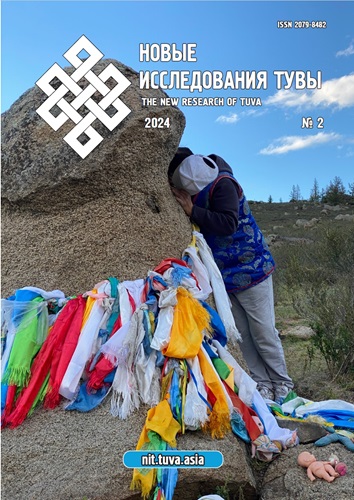Human characteristics in Tuvan riddles (based on field and lexicographic material)
DOI:
https://doi.org/10.25178/nit.2024.2.7Keywords:
riddle; human; Tuvan; Tuvan culture; body parts; metaphorAbstract
The article analyzes Tuvan riddles that reflect the stages of human life, the structure of the human body and its organs. The author uses her own card file as research material, compiled from various lexicographic sources and materials from folklore expeditions in the Sut-Khol, Tes-Khem, Dzun-Khemchik, Ulug-Khem, and Bai-Taigа kozhuuns (districts) of Tuva that she collected between 2014 and 2023.
The ontogeny of a person from birth to old age is considered in Tuvan riddles. Different tropes are used to describe body parts, with metaphorical epithets being most common. The physiological characteristics, physical and intellectual activities of a person, as well as people's interactions in society, are described.
References
Aiyzhy, E. V. (2015) The category of “Age” and the attitude towards it in the traditional culture of Tuvans. Kazanskii pedagogicheskii zhurnal, no. 5–2, pp. 415–421. (In Russ.).
Balyva, A. A. (2020) Antithesis in Tuvan and Russian riddles (based on the material of oral folk art). In: Actual problems of research of ethnoecological and ethnocultural traditions of the peoples of the Sayano-Altai : materials of the VI International Scientific and Practical Conference of Young Scientists, graduate students and students (June 30 — July 3, 2020) / ed. by E. D. Mongush. Kyzyl, Izd-vo TuvGU. 154 p. Pp. 13–14. (In Russ.).
Bochina, T. G. (2023) Numerical and color code as an element of Tuvan riddles about man. New Research of Tuva, no. 3, pp. 6–20. (In Russ.). DOI: https://doi.org/10.25178/nit.2023.3.1
Bredis, M. A. and Ivanov, E. E. (2022) Linguoculturological commentary in polylingual dictionaries of proverbs. Russian Journal of Lexicography, no. 26, pp. 5–29. (In Russ.). DOI: https://doi.org/10.17223/22274200/26/1
Bredis, M. A., Lomakina, O. V., Borisova, A. S. and Lazareva, O. V. (2022) [Numerical code of Tuvan linguistic culture in proverbs (as contrasted to a number of Turkic and Mongolian languages of the peoples of Russia). New Research of Tuva, no. 4, pp. 276–293. (In Russ.). DOI: https://doi.org/10.25178/nit.2022.4.20
Ivanov, E. E. (2023) Categorization of Attitude to Reality in Paremiological Units. RUDN Journal of Language Studies, Semiotics and Semantics, vol. 14, no. 4, pp. 1154–1177. (In Russ.). DOI: https://doi.org/10.22363/2313-2299-2023-14-4-1154-1177
Ivanov, E. E., Lomakina, O. V. and Petrushevskaya, J. A. (2021) The National Specificity of the Proverbial Fund: Basic Concepts and Procedure for Determining. RUDN Journal of Language Studies, Semiotics and Semantics, vol. 12, no. 4, pp. 996–1035. (In Russ.). DOI: https://doi.org/10.22363/2313-2299-2021-12-4-996-1035
Ivanov, E. E. and Mongush, Sh. V. (2023) Linguoculturological commentary in the Tuvan-Russian-English Paremiological Dictionary. New Research of Tuva, no. 3, pp. 65–83. (In Russ.). DOI: https://doi.org/10.25178/nit.2023.3.5
Kenin-Lopsan, M. B. (1994) Traditional ethics of Tuvans. Kyzyl, Izdatel'stvo «Novosti Tuvy». 192 p. (In Tuv.).
Kurbatskii, G. N. (2001) Tuvans in their folklore: historical and ethnographic aspects of Tuvan folklore. Kyzyl, Tuvinskoe knizhnoe izd-vo. 464 p. (In Russ.).
Lomakina, O. V. (2018) Phraseology in the text: functioning and idiostyle. Moscow, RUDN. 344 p. (In Russ.).
Lomakina O. V. (2022) Tuvan paremiology: its linguoculturological and linguoaxiological potential. New Research of Tuva, no. 1, pp. 6–16. (In Russ.). DOI: https://doi.org/10.25178/nit.2022.1.1
Lomakina O. V. (2023) Value Constants of the Russian World: cognitive analysis of paroemias. Kognitivnye issledovaniia iazyka, no. 3–1 (54), pp. 745–750. (In Russ.).
Neliubova, N. Yu., Dugalich, N. M., Kadilina, O. A. and Kol, Ch. Sh. (2023) Linguoaxiological Analysis of Kalmyk Proverbs and Sayings with Food-Related Components: A Perspective from European Paremiological Contexts. Oriental Studies, vol. 16, no. 4, pp. 929–947. (In Russ.). DOI: https://doi.org/10.22162/2619-0990-2023-68-4-929-947
Neliubova, N. Yu., Lomakina, O. V. and Mirzaeva, S. V. (2023) LABOR in the Paradigm of the Values of European and Asian Peoples: on the Basis of Russian, French and Kalmyk Proverbs. RUDN Journal of Language Studies, Semiotics and Semantics, vol. 14, no. 3, pp. 595–615. (In Russ.). DOI: https://doi.org/10.22363/2313-2299-2023-14-3-595-615
Seregina, M. A. (2016) Paremia as a form of representation of people's knowledge in language: cognitive and structural aspect. Issues of cognitive linguistics, no. 1, pp. 19–25. (In Russ.).
Soian, A. M. (2023) The image of the horse in Tuvan riddles. New Research of Tuva, no. 3, pp. 84–96. (In Russ.). DOI: https://doi.org/10.25178/nit.2023.3.6
Soian, A. M. and Lomakina, O. V. (2024) The image of the yurt in Tuvan paremiology: a cognitive approach. Kognitivnye issledovaniia iazyka. Issue № 1 (57): Modern languages and cultures: variability, functions, ideologies in the cognitive aspect, part II, pp. 103–107. (In Russ.).
Sundui, G. D. (2009) The world of childhood in nomadic Asia: the experience of spiritual and moral education. Kyzyl, Institut razvitiia natsional'noi shkoly. 168 p. (In Russ.).
Togui-ool, A. S. (2001) Research. Kyzyl, Tyvanyng nom ündürer cheri. 96 p. (In Tuv.)
Faizullina, N. I. (2018) The structural organization of the Russian and English folk riddles. Vestnik Severnogo (Arkticheskogo) federal'nogo universiteta. Seriia: Gumanitarnye i sotsial'nye nauki, no. 3, pp. 124–132. (In Russ.).
Chesnokova, O. S. and Usmanov, T. F. (2022) Images of Nature in Tuvan, Tatar, Russian, and Spanish Riddles. RUDN Journal of Language Studies, Semiotics and Semantics, vol. 13, no. 2, pp. 483–501. (In Russ.). DOI: https://doi.org/10.22363/2313-2299-2022-13-2-483-501
Published
How to Cite
For citation:
Soyan A. M. Human characteristics in Tuvan riddles (based on field and lexicographic material). New Research of Tuva, 2024, no. 2, pp. 112-124. (In Russ.). DOI: https://doi.org/10.25178/nit.2024.2.7
Issue
Section

This work is licensed under a Creative Commons Attribution-NonCommercial 4.0 International License.

Author(s) license holder(s) grant rights for their work to the journal (grantee of a license) under the simple non-exclusive open license in accordance with Art. 1286.1 «Open license for a research work, work of literature or fine arts», Civil Code of the Russian Federation.
New Research of Tuva publishes articles under the Creative Commons Attribution-NonCommercial license (CC BY-NC).
Since it is an open license, author(s) reserve the right to upload the article to their institutional repository, submit it to another journal (if it allows republications), or republish it on their own website (in full, or in part).
However, several conditions apply here:
a) The republished version must always contain the name(s) and affiliation(s) of the author(s), the original title and the hyperlink to the original version on the New Research of Tuva website;
b) It must be in open access, free of charge, and no category of readers must be in any way whatsoever advantaged over general readership.
c) should the contribution be submitted elsewhere by its author(s) without substantial modification (30% or more of original text unchanged), the body of the article should contain a disclaimer that the original version was published in New Research of Tuva (with a link to the respective page)
The CC-BY-NC is a non-revocable license which applies worldwide and lasts for the duration of the work’s copyright.









